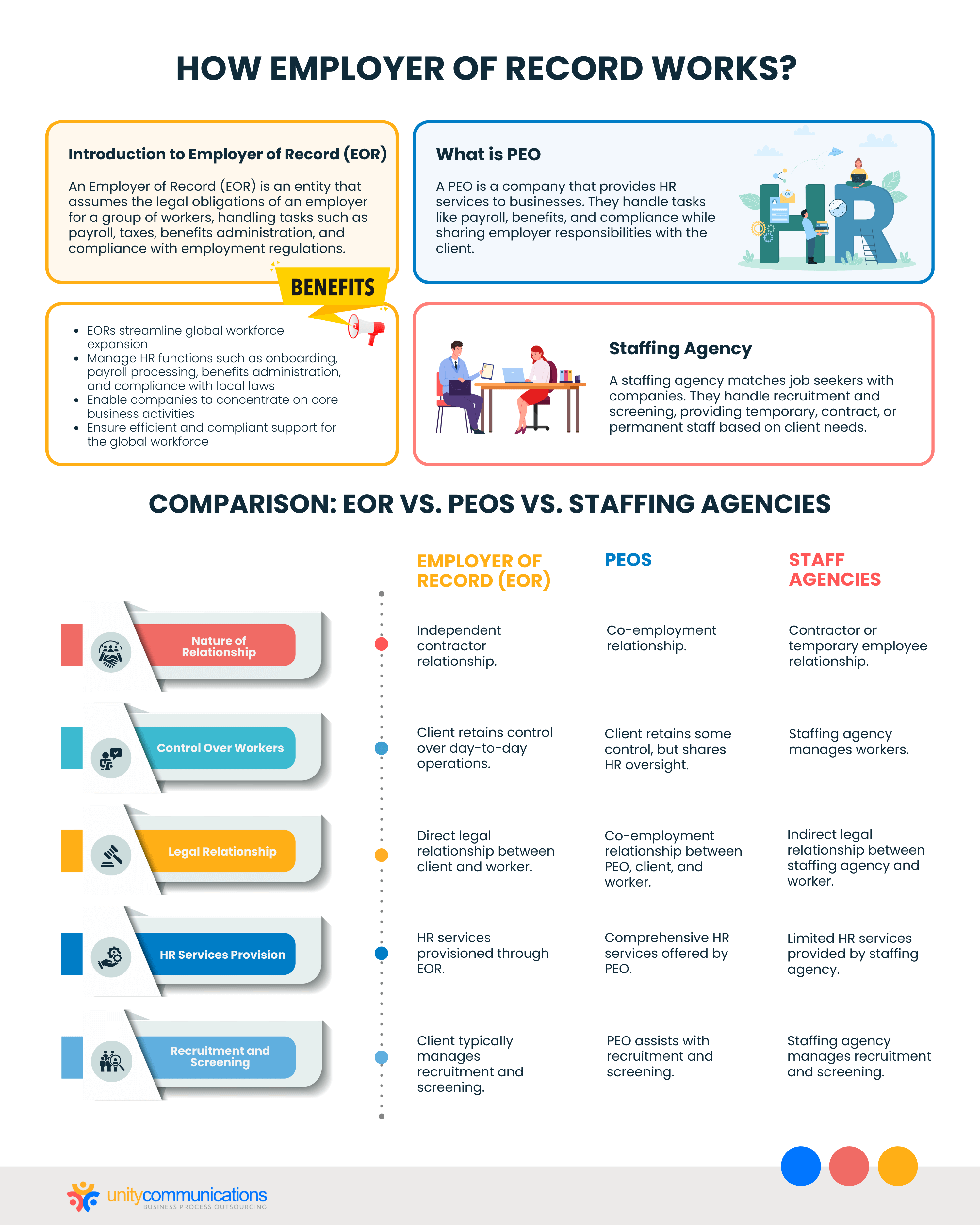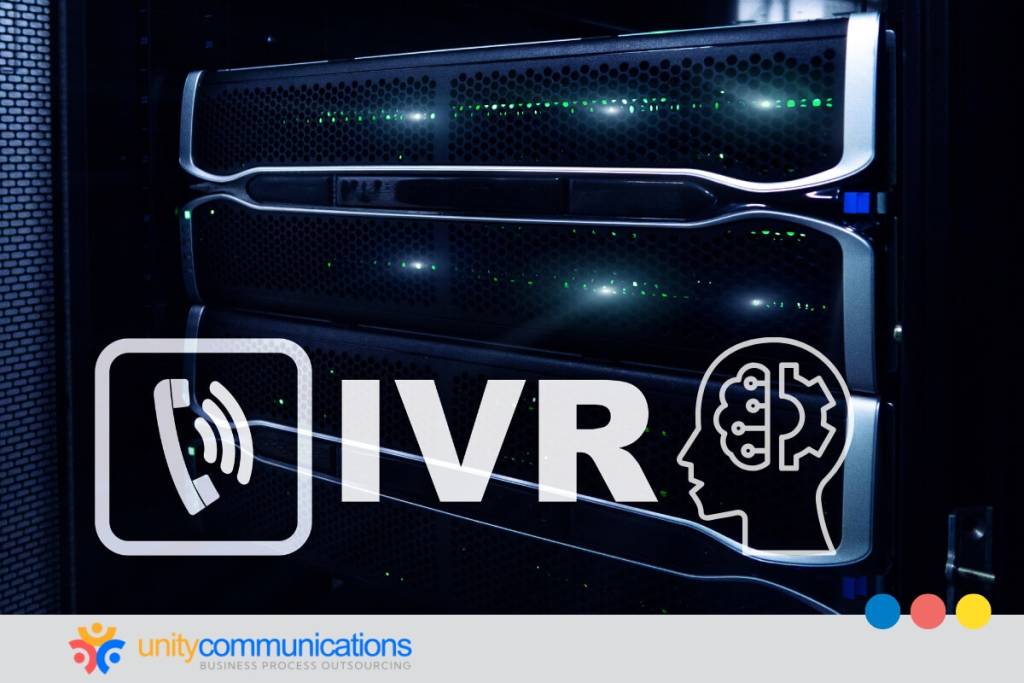Table of Contents
Navigating the complexities of workforce management leads businesses to explore various employment solutions. Employer of record (EOR) services emerge as a compelling option.
This article explores how the employer of record works and compares it with professional employer organizations (PEOs) and staffing agencies. By examining each model’s control, compliance, and cost structures, businesses can effectively make informed decisions for their specific needs and optimize their workforce strategies.
Read until the end to learn valuable tips for choosing the best employment model to manage your workforce.
Deciphering How the Employer of Record Works

EOR is gaining popularity for providing a streamlined approach to managing contingent workforces. Unlike direct hiring, it involves delegating employer responsibilities to a third-party provider, allowing client companies to focus on core operations while reducing compliance risks.
An example of a third-party provider that offers EOR services is a business process outsourcing (BPO) company that can handle administrative tasks and ensure the client’s compliance with employment regulations. It can also deliver other benefits, including outsourced data entry services, information technology (IT) support, and customer service.
EOR assumes the client’s legal obligations, including payroll processing, tax withholding, benefits administration, and regulatory compliance. Nonetheless, comprehending the distinctions between how the employer of record works compared to PEOs and staffing agencies is crucial. Each option offers benefits, addressing varied business needs and goals.
A Brief Glance at EOR vs. PEOs and Staffing Agencies
PEOs operate on a co-employment model, sharing employer responsibilities with clients. This agreement allows firms to access payroll administration, employee benefits, and other human resources (HR) services in which they do not excel. PEOs extend the client’s HR capabilities, offering expertise in navigating intricate employment regulations.
In contrast, staffing agencies primarily recruit, screen, and match individuals for temporary, contract, or permanent positions with clients. They liaise between companies and job seekers, simplifying the recruiting process and regularly dealing with administrative tasks such as providing payroll and benefits for temporary employees.
While all three models provide HR management solutions, their operational procedures and commercial ramifications differ significantly. Understanding these distinctions is essential for clients seeking the most suitable employment arrangement for their organizational needs.
Comparing How the Employer of Record Model Works Against Others

Several vital considerations come into play when comparing EOR with other employment models, such as PEOs and staffing agencies. These include control and flexibility, legal responsibilities and compliance, and cost structure. The following section delves into the details.
Control and Flexibility
One significant aspect to consider is the client’s degree of control and flexibility under each model. Let’s examine every option.
How the employer of record works:
- Retained control. With an EOR, businesses control day-to-day operations and task assignments. They dictate the workflow and oversee the activities of their contingent workers.
- Task assignment flexibility. Businesses can assign tasks to contingent workers based on their needs and priorities. Additionally, they can adjust assignments dynamically to meet changing demands.
- Administrative offloading. EORs handle administrative tasks such as payroll processing, tax withholding, and benefits administration. By offloading these duties, businesses can concentrate on their core operations without worrying about administrative complexity.
How PEOs work:
- Shared employer responsibilities. PEOs share employer duties with the clients under a co-employment model. Though businesses retain daily control, they relinquish some HR oversight to the provider.
- Accessible HR expertise. PEOs offer complete HR services and expertise, such as payroll administration, benefit management, and compliance assistance. While businesses benefit from the PEO’s expertise, they might need more direct control over HR processes.
- Flexible HR services. PEOs offer flexibility in accessing HR services tailored to the needs of client companies. Companies can select from various services provided by the PEO, modifying their involvement level according to evolving needs.
How staff agencies work:
- Outsourced recruitment. Staffing agencies recruit, source, screen, and select candidates for clients. While this process provides convenience, it might result in less company control over selection.
- Temporary worker management. Staffing agencies manage temporary workers’ employment, including payroll and benefits. While this relieves administrative burdens for client companies, it might entail less direct control over employee management.
- Flexible staffing. Staffing agencies let businesses scale their workforce based on demand without long-term commitments, ensuring agility in meeting fluctuations.
Legal Responsibilities and Compliance
Another critical consideration is how these models ensure adherence to labor laws and regulations for each employment solution.
How the employer of record works:
- Strict adherence to employment laws. EORs ensure compliance with local, state, and federal employment laws and stay updated to mitigate legal risks for client companies.
- Thorough legal documentation. EORs manage legal documents (e.g., contracts, agreements, and notices), ensuring compliance and minimizing legal risks.
- Assured tax compliance. EORs manage payroll and tax compliance, reducing administrative burdens for client companies and ensuring accuracy and compliance with regulations.
How PEOs work:
- Regulatory compliance support. PEOs assist clients in navigating complex employment regulations and ensuring compliance with labor laws and other statutory requirements. They stay updated on changes in legislation and guide clients.
- Managed employee relations. PEOs handle employee relations matters, including disputes, grievances, and disciplinary actions. They ensure all actions comply with legal requirements, reducing legal disputes or litigation.
- Offered training. PEOs provide educational resources to clients to ensure awareness and understanding of legal obligations and compliance requirements. They share best practices and give regulatory updates to help businesses maintain compliance.
How staff agencies work:
- Proper background checks and screening. A staffing agency conducts thorough background evaluations of candidates to verify their qualifications and eligibility for employment. This process ensures each candidate’s compliance with legal requirements and suitability for specific roles.
- Guaranteed health and safety compliance. Staffing agencies ensure the client’s compliance with health and safety regulations, prioritizing worker protection from workplace hazards and accidents.
- Correct worker classification. Staffing agencies classify workers correctly as employees or independent contractors according to legal guidelines. They follow laws to avoid misclassification penalties and legal liabilities for clients.
Cost Structure
Each employment solution’s cost implications can significantly influence business decision-making. Let’s explore each choice.
How the employer of record works:
- Service-based fees. EORs typically charge a service-based fee, which depends on employee count, service scope, and engagement duration. Client companies pay only for the specific services they require.
- Customized pricing. EORs tailor pricing to fit client needs. Their flexible options adapt to workforce changes, ensuring cost-effectiveness.
- Predictable budgeting. BPO companies offering outsourcing IT support, customer support, and EOR services provide predictable and outlined costs, aiding client companies’ resource allocation and budget planning.
How PEOs work:
- Co-employment fees. PEOs typically charge a co-employment fee, a percentage of total employee wages, or a fixed amount per employee. This fee covers the services the PEO provides to clients.
- Administrative fees. PEOs might also charge administration fees to cover the costs of payroll processing, benefits administration, HR support, and other administrative tasks. These rates vary per service level.
- Employee benefits costs. PEOs often negotiate group rates for health insurance, retirement plans, and other perks. The client might pay a markup on these benefits to cover the PEO’s administrative costs and ensure cost-effectiveness.
How staff agencies work:
- Employee wage markup. Staffing agencies typically charge a markup on placed employees’ hourly rates or salaries. This markup covers the agency’s recruitment, administration, and overhead expenses.
- Temporary worker fees. Clients pay fees to staffing agencies for the temporary workers they provide. These prices might fluctuate depending on the duration of the assignment, the talent necessary, and the demand for specific tasks.
- Flexible costs. Staffing agencies offer flexibility in pricing structures. This allows client companies to scale their workforce up or down according to demand without incurring fixed overhead costs associated with permanent employees.
Selecting the Right Employment Model: EOR, PEO, or Staff Agency

Before selecting an employment model to manage your workforce, consider these pointers to ensure alignment with the company’s needs and goals:
- Assess business requirements. Determine your firm’s staffing requirements, including workforce size, industry regulations, and flexibility needed.
- Evaluate control versus outsourcing. Understand the balance between maintaining control over operations and outsourcing administrative tasks for efficiency.
- Review compliance requirements. Consider your industry’s legal and regulatory landscape and ensure the chosen model can meet compliance needs.
- Analyze cost implications. Compare each model’s cost structures, including initial fees, continuing expenditures, and possible savings.
- Examine flexibility. Review the model’s capacity to respond to shifting business demands and workforce fluctuations.
- Research provider reputation. Look into possible BPO providers’ reputations and track records to guarantee service dependability and quality.
The Bottom Line

Understanding how the employer of record works compared to PEOs and staffing agencies is essential for businesses navigating the complexities of workforce management. Each employment solution offers benefits, catering to different organizational needs and preferences.
Employers can arrive at intelligent choices about HR management by evaluating control, compliance, and costs. Businesses can leverage EORs, PEOs, or staffing agencies to optimize workforce strategies and achieve objectives efficiently.
Let’s connect if you want to learn more about how the employer of record works and how it can benefit your organization!




